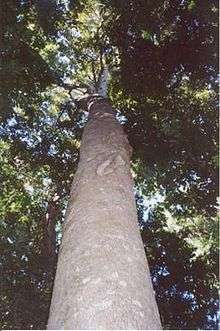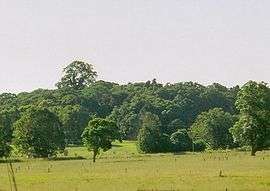Big Scrub
The Big Scrub was the largest area of subtropical lowland rainforest in eastern Australia. It was intensively cleared for agricultural use in the 19th century by colonists. Only a few remnants survived the clearing, with less than 1% now existing.[1]
Located on the North Coast of New South Wales, between what is now the towns of Byron Bay (east) and Lismore (west), the core Big Scrub area consisted of an estimated 900 square kilometres of subtropical rainforest. It primarily grows on fertile basalt and floodplain derived soils.
The Big Scrub existed in the Bundjalung Aboriginal Nation. Traditionally the Bundjalung (particularly those that spoke the Widgjabal language of the Bundjalung nation) traversed it via walking trails, and maintained a few grassed clearings for camping and hunting within the rainforest. Rainforest bushfood were a regular part of the traditional Bundjalung diet, including staples like Black Bean, Castanospermum australe, which is detoxified before eating.[2]
The Big Scrub was dominated by White Booyong (Heritiera trifoliolata) and Australian Red Cedar (Toona australis). The latter was eagerly sought by the 'cedar getters' for its fine quality timber. The cedar getters were the first non-indigenous people to exploit the Big Scrub area.
Later, the Government of New South Wales gave allotments to potential farmers on the basis that they cleared it of rainforest. Hence, most of the Big Scrub was cleared, and the surviving Bundjalung were placed into reservations.
In the 20th century, interest in rainforest and conservation resulted in a greater effort to conserve the few remaining remnants of the Big Scrub. The major remnants are: the Booyong Flora Reserve, Victoria Park Nature Reserve, Davis Scrub Nature Reserve, Boatharbour, and Hayters Hill Nature Reserve. These remnants have been subject to ecological restoration projects which involves the removal of invasive non-native weeds.
Big Scrub remnants have become a source of native foods for cropping, especially in recent years. These include the macadamia nut, riberry and Finger Lime. Macadamia nut is now grown commercially over much of the former Big Scrub area, but the main species used in cropping, Macadamia integrifolia, did not naturally occur in the Big Scrub.
Remnant trees of the Big Scrub
 White Beech in a remnant of the Big Scrub - Alstonville, NSW
White Beech in a remnant of the Big Scrub - Alstonville, NSW Twin White Booyong growing in a remnant of the Big Scrub - Booyong Reserve, NSW
Twin White Booyong growing in a remnant of the Big Scrub - Booyong Reserve, NSW Emergent Moreton Bay Fig growing in a remnant of the Big Scrub, Davis Scrub near Alstonville
Emergent Moreton Bay Fig growing in a remnant of the Big Scrub, Davis Scrub near Alstonville Syzygium francisii - Booyong Reserve, near Lismore, New South Wales
Syzygium francisii - Booyong Reserve, near Lismore, New South Wales
See also
- Andrew Johnston Big Scrub Nature Reserve
- Booyong Flora Reserve
- Davis Scrub Nature Reserve
- Gondwana Rainforests of Australia
- Hayters Hill
- Victoria Park Nature Reserve
References
- "Big Scrub Landcare". Retrieved 19 February 2016.
They called Australia’s largest subtropical lowland rainforest ‘The Big Scrub’ and left less than 1% of this now endangered rainforest to succeeding generations.
- "Castanospermum australe, Black Bean, Moreton Bay Chestnut". Australian National Botanic Gardens. Retrieved 19 February 2016.
The Black Bean has also proved valuable as a timber species, its seeds have been utilized - following extensive preparation as a food by Aborigines and it contains alkaloids which have been shown to have anti-HIV and anti -cancer properties.
External links
- "Homepage". Big Scrub Rainforest Landcare Group. 2014.
- "Northern Rivers Geology - Geology of the Bigscrub Part 1". Northern Rivers Geology. 2016.